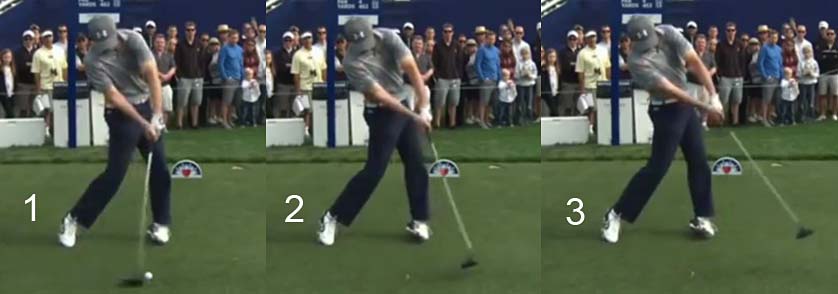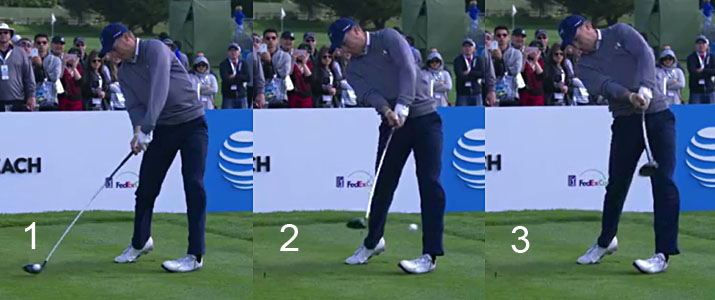
Why does Jordan Spieth, who is normally a superb DHer, sometimes flip through impact?
Click here to go back to the video project's index page.
Jordan Spieth, who is a superb PGA tour golfer, often uses a DH-hand release action (no-roll subtype) when swinging a driver.
Consider an example - Jordan Spieth driver swing video - https://www.youtube.com/watch?v=6UKHsgFnpFE
Here are capture images from the swing video.

Image 1 is at impact, image 2 is at P7.2 and image 3 is at P7.5. Note that he is maintaining a very stable clubface that is square to the clubhead arc all the way between P7 and P7.5, which means that he has very low ROC of his clubface through the immediate impact zone.
Note that Jordan Spieth has maintained a bowed left wrist and bent right wrist all the way through impact to the P7.5 position, and note that his clubshaft has not bypassed his left arm at the P7.5 position, which means that he is using a DH-hand release action in this particular driver swing action. Note that he is turning his mid-upper torso very actively through impact, which allows him to more easily perform a no-roll subtype of DH-hand release action (where the amount of clubface roll between P7 and P7.2 is primarily controlled by the upper body's rotation of his left shoulder socket inside-left, and where there is no significant external rotation of his left humeral head within the left shoulder socket during that same time period). Note that he doesn't flip (extend) his left wrist or continue to supinate his left forearm, which can predispose him to a non-DH hand release action through impact. A key biomechanical element that allows him to perform his no-roll subtype of DH-hand release action so well through impact is the fact that he is i) leading with his lead hand, while simultaneously ii) ensuring that his lead hand is moving targetwards as fast (or even fractionally faster) than his right hand through the immediate impact zone - as recommended by Ben Hogan when he described his "two-handed basketball pass from the right side" type of swing action. That's a key biomechanical concept that will allow a golfer to more efficiently perform a DH-hand release action through impact. By contrast, if the lead hand slows down slightly so that the right hand travels faster than the left hand through impact, then that biomechanical combination will more likely lead to a non-DH hand release action (left wrist flipping subtype) through impact.
Here is an example of a Jordan Spieth driver swing - where he performs a non-DH-Hand release action (left wrist flipping subtype) through impact.
https://www.youtube.com/watch?v=eAxbVje5WTo
Here are capture images from the swing video.

Image 1 is at impact, image 2 is at P7.2 and image 3 is at P7.5.
Note that his clubface is not stable through the immediate impact zone and note that it is rolling more than the amount needed to keep the clubface square to the clubhead arc. The likely biomechanical cause is due to the fact that he is extending (flipping) his left wrist, which causes the clubshaft to prematurely bypass his left arm. I think that it is very likely due to the fact that he is fractionally stalling his forward/targetwards motion of his lead hand through impact - note that he is excessively chicken-winging his left arm - while he is simultaneously straightening his right arm and his right wrist too fast during the same time period, and that combination can predispose him to a left wrist flipping sub-type of DH-hand release action through impact. His ball flight could still have been straight (if both the clubhead path and clubface angle were square at impact) in that particular driver swing action, but his clubface was slightly more unstable (with a higher ROC) during the clubhead's travel passage through the immediate impact zone - when compared to his driver swing above, where he used a DH-hand release action.
Jeffrey Mann.
February 2017.